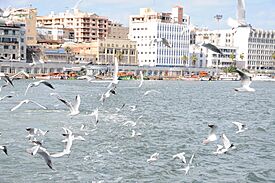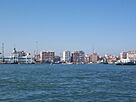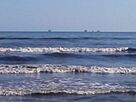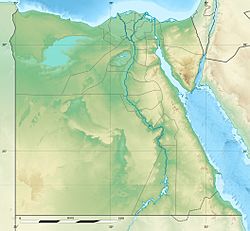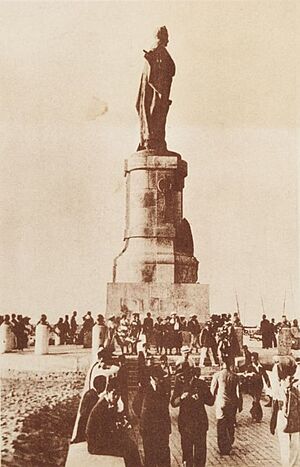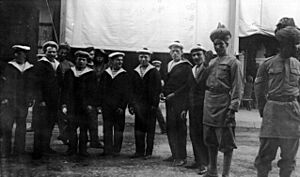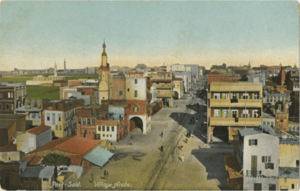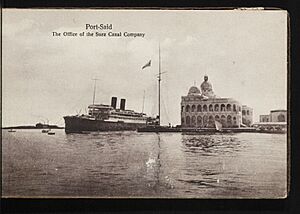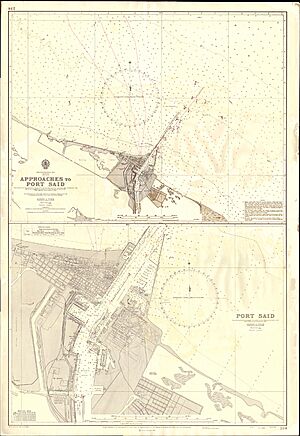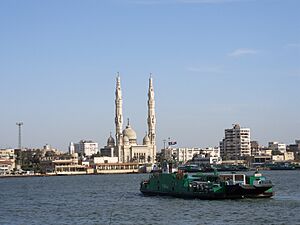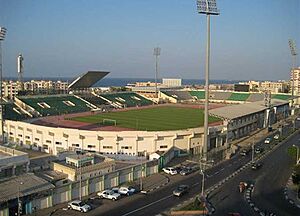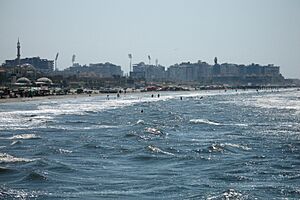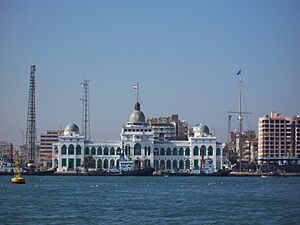Port Said facts for kids
Quick facts for kids
Port Said
بورسعيد
|
|||
|---|---|---|---|
|
Clockwise from top:
Docks of Port Said, View from the Suez Canal, Obelisk of Museum of Modern Art, Mediterranean Sea, Port Said Hotel Gardens |
|||
|
|||
| Nickname(s):
The valiant city
|
|||
| Country | Egypt | ||
| Governorate | Port Said | ||
| Founded | 1859 | ||
| Government | |||
| • Type | City-state | ||
| Area | |||
| • Total | 1,294 km2 (500 sq mi) | ||
| Elevation | 0-6 m (−19.7 ft) | ||
| Population
(2023)
|
|||
| • Total | 797,398 | ||
| • Density | 616.23/km2 (1,596.0/sq mi) | ||
| CAPMS 2023 estimate | |||
| GDP | |||
| • Total | EGP 190 billion (US$ 12.1 billion) |
||
| Time zone | UTC+2 (EGY) | ||
| Area code(s) | +20-66 | ||
| Website | PortSaid.gov.eg | ||
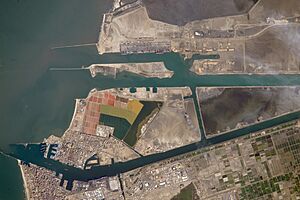
Port Said is a lively city in northeast Egypt. It stretches about 30 kilometers (19 miles) along the Mediterranean Sea coast. The city is located on the west side of the northern entrance to the Suez Canal.
Port Said is the main city of the Port Said Governorate. Most of the governorate's areas are part of the city. It was founded in 1859 when the Suez Canal was being built. In early 2023, about 680,375 people lived there.
The city has many old buildings with large balconies, giving it a special look. Port Said's twin city is Port Fuad, which is on the eastern side of the Suez Canal. These two cities work together closely. They are connected by free ferries that run all day. Together, they form a large urban area with over a million people. This area spans both the African and Asian sides of the Suez Canal. The only other city in the world that also covers two continents is Istanbul.
Port Said has always been an important global city. It grew a lot in the 1800s and early 1900s. People from many different countries and religions lived there peacefully. They formed a diverse community. The famous writer Rudyard Kipling once said that if you wanted to find someone who travels, you just needed to wait at the docks of London or Port Said.
Contents
What's in a Name?
The name "Port Said" first appeared in 1855. An international group from Great Britain, France, Russia, Austria, Spain, and Piedmont chose it.
The name has two parts. "Port" comes from the French word for a marine harbor. "Said" comes from Sa'id of Egypt, who was the ruler of Egypt at that time. He allowed Ferdinand de Lesseps to dig the Suez Canal. In ancient Greek times, the city was known as Pēloúsion.
A Look at Port Said's Past
How Port Said Began (1859)
Port Said was founded on April 25, 1859. This was when Ferdinand de Lesseps started the Suez Canal construction. At first, it was hard for ships to anchor. But then, a rocky spot was found near the shore. A wooden jetty was built to connect it to the beach. This spot became the heart of the new city. Forty years later, a monument to de Lesseps was built there.
The city had no local resources. Everything needed, like wood, stone, food, and even water, had to be brought in. Large water tanks were set up until the Sweet Water Canal was finished. A new method using "Beton Coignet" (concrete) was used to build the jetties. This same concrete was used for the Lighthouse of Port Said. It is the only original building still standing.
In 1859, only 150 workers lived in tents. A year later, the population grew to 2,000. By 1869, when the canal opened, 10,000 people lived there. The European area was near the water. The Arab area, Gemalia, was a bit further west. Over time, these areas grew together.
Port Said has played a big part in Egyptian history. The British entered Egypt through the city in 1882. This marked the start of their control over Egypt.
A Busy International Port (1902–1945)
In the early 1900s, Port Said changed a lot. In 1902, Egyptian cotton started to be shipped from Port Said. In 1904, a railway line to Cairo opened. These changes brought many businesses and raised the city's importance. A large Greek community also grew there. By 1907, the city had about 50,000 people, including 11,000 Europeans.
During World War I, Port Said had an important Allied hospital. Thousands of soldiers were sent there, including those wounded in the Gallipoli campaign in 1915. After the war, the Suez Canal Company decided to build a new city. This city, Port Fouad, was on the Asian side of the canal. It was designed by the École des Beaux-Arts in Paris and had French-style houses. Port Fouad was founded in December 1926.
People from many countries and religions moved to Port Said. Each group brought their own customs, food, and architecture. By the late 1920s, over 100,000 people lived there. In the 1930s, Italian architects designed beautiful public buildings. Port Said became a busy international port with people from all over the world. There were Jewish merchants, Egyptian shopkeepers, Greek photographers, and many more. They all lived and worked alongside the large local Egyptian community. Travelers to and from Africa, India, and the Far East also passed through. Many people spoke French, and multilingualism was common.
In 1936, the Anglo-Egyptian Treaty of 1936 was signed. This treaty said that British troops would leave Egypt, except for those needed to protect the Suez Canal.
Modern Port Said: Revolution and Growth (1946–Present)
After World War II, Egypt ended the 1936 treaty. This led to conflicts with British troops near the Suez Canal in 1951. The Egyptian Revolution of 1952 then happened. On July 26, 1956, President Gamal Abdel Nasser took control of the Suez Canal Company. This caused problems with Britain and France. They worked with Israel to invade Egypt in what is known as the Suez Crisis.
On November 6, 1956, British troops arrived in Port Said. There was fighting, and many people were affected. Fires also damaged much of the city. The last foreign soldiers left on December 23, 1956. This day is now Port Said's national day, celebrated every year. After the Suez Crisis, many people from European backgrounds who lived in Port Said moved to other countries.
After the 1967 Arab-Israeli war (the Six-Day War), the Suez Canal was closed until 1975. The Egyptian government moved residents out of Port Said to prepare for the Yom Kippur War (1973). The city was re-inhabited after the war and the canal reopened. In 1976, Port Said became a duty-free port. This attracted people from all over Egypt. Today, the city has a population of over 600,000.
Economy: How Port Said Works
Port Said is a very important city in Egypt. It was ranked second among Egyptian cities for human development in 2009 and 2010. The city's economy relies on fishing and industries. These industries include chemicals, ultra-processed food, and cigarettes.
Port Said is also a key harbor for exporting Egyptian goods. These include cotton and rice. Ships passing through the Suez Canal often stop here for fuel. Being a duty-free port means goods are cheaper, which attracts tourists. It is also a popular place for summer holidays. The Lighthouse of Port Said is here, which was the first building in the world made from reinforced concrete.
Because of its great location, Port Said is a good place for businesses. It attracts companies involved in shipping and trade. In 2019, the New Suez Canal was built, led by Egyptian President Abdel Fattah el-Sisi.
East Port Said Industrial Zone
The government offers special benefits to businesses that invest in this area. These benefits include no taxes or duties on tools, machines, and raw materials. This is for goods that are made for export.
Geography and Weather
Climate: What's the Weather Like?
Port Said has a hot desert climate. However, winds from the Mediterranean Sea make the temperatures milder. This is typical for Egypt's northern coast. Summers are moderately hot and humid. Winters are mild and a bit wet. Sometimes, sleet and hail can fall, but less often than in Alexandria. January and February are the coolest months. July and August are the hottest.
The highest temperature ever recorded was 44°C (111°F) on June 20, 1988. The lowest was 0°C (32°F) on December 25, 1979. Port Said has some of the smallest temperature changes in Egypt. It also has cooler summer days than many other cities.
| Climate data for Port Said (Port Said Airport) 1991–2020 | |||||||||||||
|---|---|---|---|---|---|---|---|---|---|---|---|---|---|
| Month | Jan | Feb | Mar | Apr | May | Jun | Jul | Aug | Sep | Oct | Nov | Dec | Year |
| Record high °C (°F) | 29.7 (85.5) |
31.9 (89.4) |
34.6 (94.3) |
41.8 (107.2) |
45.0 (113.0) |
39.8 (103.6) |
36.4 (97.5) |
35.1 (95.2) |
35.6 (96.1) |
34.8 (94.6) |
33.9 (93.0) |
25.9 (78.6) |
45.0 (113.0) |
| Mean daily maximum °C (°F) | 18.3 (64.9) |
18.7 (65.7) |
20.6 (69.1) |
22.9 (73.2) |
25.7 (78.3) |
28.8 (83.8) |
30.8 (87.4) |
31.3 (88.3) |
29.9 (85.8) |
27.6 (81.7) |
24.0 (75.2) |
20.1 (68.2) |
24.9 (76.8) |
| Daily mean °C (°F) | 14.7 (58.5) |
15.1 (59.2) |
16.9 (62.4) |
19.2 (66.6) |
22.3 (72.1) |
25.4 (77.7) |
27.3 (81.1) |
28.0 (82.4) |
26.9 (80.4) |
24.6 (76.3) |
20.8 (69.4) |
16.6 (61.9) |
21.5 (70.7) |
| Mean daily minimum °C (°F) | 11.6 (52.9) |
12.1 (53.8) |
14.1 (57.4) |
16.4 (61.5) |
19.6 (67.3) |
22.7 (72.9) |
24.6 (76.3) |
25.3 (77.5) |
24.3 (75.7) |
22.1 (71.8) |
18.2 (64.8) |
13.6 (56.5) |
18.7 (65.7) |
| Record low °C (°F) | 4.2 (39.6) |
6.2 (43.2) |
5.0 (41.0) |
9.1 (48.4) |
12.0 (53.6) |
17.7 (63.9) |
20.2 (68.4) |
20.2 (68.4) |
19.5 (67.1) |
14.4 (57.9) |
2.2 (36.0) |
6.6 (43.9) |
2.2 (36.0) |
| Average precipitation mm (inches) | 16.3 (0.64) |
12.0 (0.47) |
10.6 (0.42) |
3.8 (0.15) |
1.5 (0.06) |
0.1 (0.00) |
0.0 (0.0) |
0.0 (0.0) |
0.0 (0.0) |
4.3 (0.17) |
4.8 (0.19) |
7.8 (0.31) |
61.4 (2.42) |
| Average precipitation days (≥ 1.0 mm) | 3.2 | 2.9 | 1.6 | 1.1 | 0.3 | 0.0 | 0.0 | 0.0 | 0.0 | 0.7 | 1.2 | 2.0 | 13.0 |
| Average relative humidity (%) | 68 | 66 | 65 | 64 | 66 | 67 | 68 | 68 | 68 | 65 | 67 | 69 | 67 |
| Average dew point °C (°F) | 8.9 (48.0) |
8.8 (47.8) |
10.1 (50.2) |
12.7 (54.9) |
15.5 (59.9) |
18.8 (65.8) |
20.7 (69.3) |
21.2 (70.2) |
19.8 (67.6) |
17.5 (63.5) |
14.3 (57.7) |
10.6 (51.1) |
14.9 (58.8) |
| Mean monthly sunshine hours | 213.9 | 206.2 | 266.6 | 294.0 | 337.9 | 360.0 | 378.2 | 365.8 | 330.0 | 310.0 | 261.0 | 204.6 | 3,528.2 |
| Mean daily sunshine hours | 6.9 | 7.3 | 8.6 | 9.8 | 10.9 | 12.0 | 12.2 | 11.8 | 11.0 | 10.0 | 8.7 | 6.6 | 9.6 |
| Source 1: NOAA (humidity, dew point, records 1961–1990) | |||||||||||||
| Source 2: Arab Meteorology Book (sun) | |||||||||||||
City Layout and People
Port Said is divided into seven main areas, called districts. These are:
- Al-Ganoub District
- Al-Zohour District
- Al-Dawahy District
- Al-Sharq District
- Al-Manakh District
- Al-Arab District
- Gharb District
These districts are further divided into eight police wards, called qism. In January 2023, the total population of these wards was about 680,375 people.
Public Spaces: Squares and Gardens
Port Said has several public squares where people can gather:
- Mansheya Square, in Al-Sharq district
- Al-Shohda Square, in Al-Sharq district
- AL-Mohafza Square (The governorate Square), in Al-Sharq district
- AL-Sayed Metwaly Square (formerly Al-Estad Square), in Al-Manakh district
- Volgograd Square, in Al-Manakh district
- Bizerte Square, in Al-Zohour district
- Haye Al-Zohour Square, in Al-Zohour district
- AL-Horeya garden Square, in Port Fouad city
The city also has many beautiful gardens for relaxation:
- Ferial Garden
- The History Garden
- Montaza Gardens
- Al-Amal Garden
- Al-Farama Garden
- AL-Horeya Garden
- Saad Zaghlul Garden
- Restaurants Complex
Learning in Port Said
Colleges and Universities
Port Said has several places for higher education:
- Port Said University is a public university. Its engineering and science faculties are well-known.
- The Arab Academy for Science and Technology and Maritime Transport is a semi-private school. It offers courses for high school, college, and graduate students.
- Sadat Academy for Management Sciences is a public academy under the Ministry of Higher Education.
Schools
Port Said has about 349 schools. These include government schools, experimental schools, private language schools, and historic French schools.
Getting Around Port Said
Port: A Busy Seaport
The port of Port Said is very busy. It is the 28th busiest seaport in the world for container transport. It is also the second busiest in the Arab world and the busiest in Egypt. In 2009, it handled 3,470,000 TEU (a measure for containers). The port is part of the Maritime Silk Road.
The port is divided into two main parts:
- Port Said Port
- East Port Said Port
The port entrance is protected by two long walls called breakwaters. The western breakwater is about 3.5 miles (5.6 km) long. The eastern breakwater is about 1.5 miles (2.4 km) long.
Airports: Flying In and Out
Port Said has its own airport, Port Said Airport. It is about 6 kilometers (3.7 miles) from the city center. The airport reopened in February 2011 after being updated for international flights. Regular flights had stopped in 1996.
Motor Highways: Roads to Other Cities
Three main highways connect Port Said to other cities in Egypt:
- The International Coastal Road (west): This 257 km (160 mi) highway connects Port Said to Alexandria along the Mediterranean Sea coast.
- The Desert Road: This 215 km (134 mi) road goes south from Port Said to Cairo, via Al Ismaileya.
- The International Coastal Road (east): This 53 km (33 mi) highway connects Port Said to Damietta.
Train: Rail Travel
The Port Said train station is on Mustafa Kamal Street. It was built around 1904. There are frequent train services from Cairo, Alexandria, and other major Egyptian cities to Port Said. A trip from Cairo to Port Said takes about four hours. From Alexandria, it takes about six hours. You can book tickets online.
Ferry: Crossing the Canal
Port Said is connected by ferry to its twin city, Port Fouad. Port Fouad is considered the Asian part of this governorate. The ferry crosses the Suez Canal between the two cities. It carries both people and cars for free. The trip takes less than 10 minutes.
Other Ways to Get Around
Public buses are run by the Port Said Governorate. You can also find private mini-buses (14 seats). White and blue saloon car taxicabs are also available at fair prices.
Culture and Fun
Libraries: Places to Read
The Port Said Library had about 14,000 books when it opened. It was filled with encyclopedias and modern reference books.
Theaters: Enjoying Shows
Port Said has about 11 theaters. The Port Said Opera House opened on December 28, 2016. It hosts Arabic music, classical music, opera, and ballet.
Museums: Exploring History and Art
- Port Said National Museum: Located on Palestine Street, it has about 9,000 items. These items tell the story of Port Said and Egypt.
- Port Said Military Museum: Opened in 1964, it tells the story of Egyptian resistance during the Suez Crisis in 1956. It also covers the wars of 1967 and 1973.
- Museum of Modern Art in Egypt: This museum is in Shohada Square. It is beneath the Port Said Martyrs Memorial.
- Museum of the Authority of the Suez Canal: Opened in 2015, it tells the story of the Suez Canal from its beginning.
Parks: Green Spaces
Port Said has 23 parks. Some of the largest include:
- Ferial Park (21,904 square meters)
- Farma Park (12,469.4 square meters)
- Khazanat Park (2,000 square meters)
- Aldawlia Park (8 Hektars)
Sports: Staying Active
The most popular sport in Port Said is football. People in Port Said are very passionate about their local team, Al Masry SC.
Al Masry Club Stadium is a large stadium in Port Said. It was built in 1954 and can hold 17,988 people. It is mainly used for football matches. It has hosted international events like the 1997 FIFA U-17 World Championship and the 2006 Africa Cup of Nations.
Handball is the second most popular sport. The city's local handball team, Port Said SC, has won three Egyptian Handball League titles. They also won the African Handball Champions League in 1990.
Port Said Hall is an indoor sports hall. It hosts handball, basketball, and volleyball games. It was used for the 1999 World Men's Handball Championship and can hold 5,000 people. Other sports like hockey and swimming are also played.
Language: The Port Saidi Accent
The way people speak Egyptian Arabic in Port Said is unique. It's known as the Port Saidi accent.
Tourism: What to See and Do
Port Said is a popular place for summer holidays and tourists. People come for its public and private beaches, its diverse history, museums, and duty-free port. Other famous sights include the Port Said Lighthouse and the Port Said Martyrs Memorial. This memorial looks like ancient Egyptian obelisks. The building of the Suez Canal Authority headquarters is also a landmark.
Tennis Island, located in Lake Manzaleh, is another place that attracts tourists. It is an ancient Islamic city that was destroyed during the crusades.
Ashtoum el-Gamil is a protected area. It is 7 km (4.3 mi) west of Port Said. This is where Lake Manzalah connects with the Mediterranean Sea. The area is very important for birds. It covers 180 square kilometers (69 sq mi) and was created in 1988 to protect migratory birds.
Near El Gameel area, a new project called "Downtown Portsaid" is being built. It will have homes, shops, and attractions for residents, tourists, and investors.
Famous People from Port Said
- Abdulrahman Fawzi, former Egyptian football player
- Abdel Rahman Shokry, Egyptian poet
- Amr Diab, famous Egyptian singer and composer
- El-Sayed El-Dhizui, former Egyptian football player and top scorer
- Ahmed El Shenawy, Egyptian football player
- George Isaac, Egyptian activist
- Hans Dijkstal, Dutch politician
- Ibrahim El Batout, Egyptian director
- Kamal Darwish, former president of Zamalek SC
- Mohamed Atalla, engineer and inventor
- Mohamed Shawky, professional football player
- Mohamed Zidan, professional football player
- Mosaad Nour, former Egyptian football player
- Mahmoud Yassin, Egyptian Actor
- Soheir Ramzi, Egyptian actress
- Yves F. Barbaza, French World War I flying ace
Sister Cities
Port Said is connected with other cities around the world:
Images for kids
See also
 In Spanish: Puerto Saíd para niños
In Spanish: Puerto Saíd para niños


